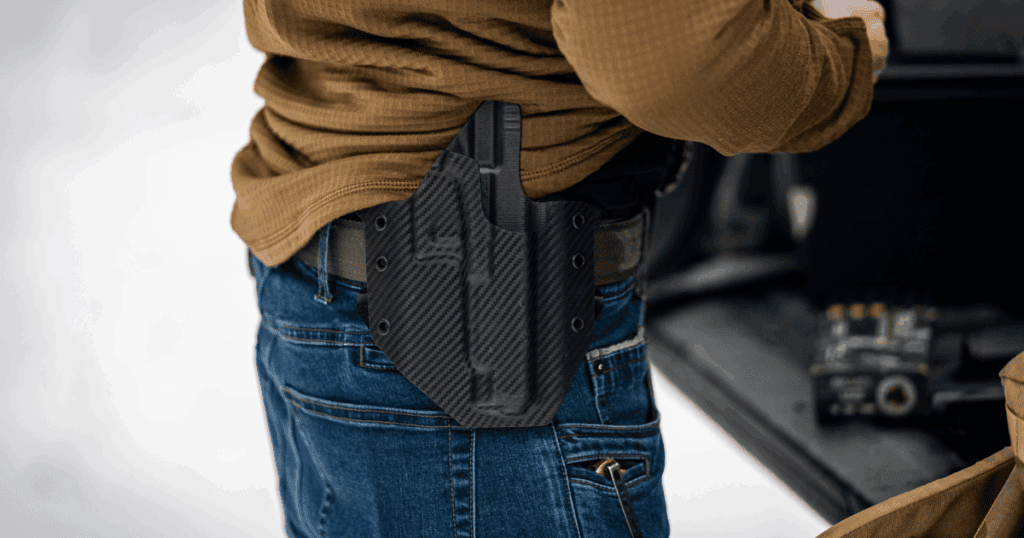Not every holster fits both the shooting range and your daily carry needs. Each environment puts different demands on your setup, so it’s smart to know what to look for and what to avoid when choosing a holster for either role.
What Makes a Holster “Range-Ready” vs. “EDC-Friendly”?
Range holsters give you freedom of movement and fast access, which is perfect for training. EDC holsters, on the other hand, offer low visibility and all-day wearability, which is perfect for daily life.
Range-Ready Holsters
At the range, the focus is on access, draw speed, and durability. You’re running drills, drawing and reholstering repeatedly, sometimes with gloves or under stress. That means your holster needs to:
- Hold up to hard use – You’ll be drawing fast, reholstering often, maybe training in dust, mud, or rain.
- Offer quick, smooth access – A looser-fitting jacket or exposed waistband makes it easy to run OWB (outside-the-waistband) holsters, which are faster to draw from.
- Stay rock-solid – No wiggling, no shifting. A stable holster helps you train with precision and build reliable muscle memory.
EDC-Friendly Holsters
Carrying a gun every day is a different game. You’re moving through daily life (driving, sitting, standing in line) while trying to keep your firearm hidden and secure. That’s why EDC holsters focus on:
- Concealment – You want a profile that doesn’t print under your clothes, especially if you wear a T-shirt or lighter layers.
- Comfort – If it’s not comfortable, you won’t carry it. Inside-the-waistband (IWB) holsters often win here, especially with contoured shapes and sweat guards.
- Retention – You’re not drawing often, but you need to trust that the gun will stay put during your daily routine.
The good news is that some holsters (especially modular or hybrid holsters) are designed to handle both. That’s where smart design, quality materials, and adjustable features matter.
Features of Holsters That Transition
If you want one holster that works at the range and for everyday carry, it needs to check more than one box. A good crossover holster allows you to train hard and carry smart, without switching gear every time. Here are the features that make that possible:
- Ergonomic designs – Holsters with contoured backings or soft edges reduce rubbing and pressure. Slim profiles help avoid printing while still offering easy access.
- Modular belt attachments – Swapping carry styles without buying a whole new holster is a major plus. Modular attachments let one holster work across multiple setups.
- Durable, tactical construction – Crossover holsters have to be tough enough for training abuse but subtle enough to conceal under a shirt. Materials like molded Kydex or reinforced nylon offer rigidity and long-term wear. Look for models that won’t deform in heat, collapse when empty, or snag under stress.
The bottom line: A transitional holster should feel like a natural extension of your gear, whether you’re on the firing line or running errands. Choosing one with these features means fewer compromises and more confidence every time you carry.
The Advantage of a Consistent Holster Platform
Switching holsters all the time might seem like no big deal – until it slows you down or throws off your draw under pressure. That’s where a consistent holster platform makes a real difference.
- Muscle memory that sticks – A consistent setup builds solid muscle memory. You know exactly where your grip will be, how much force the draw takes, and how your body needs to move.
- Less time swapping gear – When your range holster and your EDC holster are the same, you spend less time adjusting, testing, or second-guessing your gear.
- More confidence, faster response – When your draw stroke feels natural and consistent, everything from dry-fire practice to real emergencies gets sharper and faster. You’re not fumbling or overthinking. You trust your setup to do what it’s supposed to do.
GunfightersINC Holsters That Bridge the Gap
Some holsters are built for range use. Others are built for everyday carry. GunfightersINC holsters are built for both.
Ronin OWB Holster

The Ronin Holster is a classic outside-the-waistband holster built tough enough for hard training days but sleek enough for concealed carry. Whether at the range or out and about, the Ronin makes it easy to carry one holster confidently.
- High-ride, close-to-body profile makes it easy to conceal under a hoodie or light jacket.
- Kydex construction stays rigid through repeated draws and reholsters, perfect for range reps.
- Comes standard with forward cant, placing your grip where your hand naturally rests.
For more on the Ronin, read Designing Your Perfect Ronin OWB Holster and Ronin vs Sentinel vs OWB Holsters.
Spectre Shoulder Holster

The Spectre Shoulder Holster offers a unique hybrid solution for colder months or jacket carry. It’s a solid pick for anyone who prefers an off-belt carry method but needs range-ready reliability.
- Fully adjustable harness distributes weight for all-day wear.
- Designed to ride high and tight, minimizing printing under a jacket or overshirt.
- Ideal for cold-weather concealed carry, but strong enough for dynamic range work.
- Paired with dual magazine carriers for balance and backup.
For more help, check out the Concealed Carry Shoulder Holster Guide and Chest Holster vs Shoulder Holster vs Hip Holster.
Train How You Carry, Carry How You Train
Everything gets simpler and safer when your holster works for the range and everyday life. You build muscle memory that sticks, reduce gear changes, and stay more consistent under pressure.
July 14, 2025
